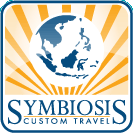Papua New Guinea Liveaboard Diving
Price upon request
Dive Papua New Guinea with Febrina
Overview | Walindi/Walindi | Walindi/Rabaul | Rabaul/Rabaul
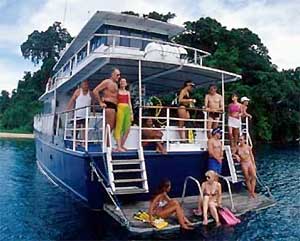
If you're the type who loves to enjoy five dives per day, interrupted only by the occasional hearty meal and chance to relax, then MV Febrina is the choice for you.
FeBrina delivers non-stop action for the dive fanatic, especially the dedicated underwater photographer.
MV FeBrina cruises from Walindi Plantation Resort, the renowned dive resort located in Kimbe Bay on the North Coast of New Britain, Papua New Guinea. Walindi, with its fern draped bungalows nestled amongst beach front rain forest, is a perfect home base from which to begin and/or end your FeBrina dive trip.
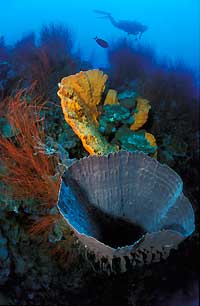 This superb live-aboard dive vessel is specifically outfitted to allow divers access to the reefs surrounding West New Britain and New Ireland, in Papua New Guinea's two main islands.
This superb live-aboard dive vessel is specifically outfitted to allow divers access to the reefs surrounding West New Britain and New Ireland, in Papua New Guinea's two main islands.
The service aboard M.V. Febrina is of high standard and the owner / skipper, Alan Raabe, ensures every trip is a unique and wonderful adventure.
In addition to the best diving in Kimbe Bay, FeBrina reaches well beyond the range of day trips to areas not otherwise accessible to scuba divers, such as the Witu Islands, Father's Reefs, Rabaul, Duke of York Islands and Kavieng in northern New Ireland. During certain times of the year, FeBrina offers special 10 and 14 day excursions to the outer reefs, in addition to the usual one week trips.
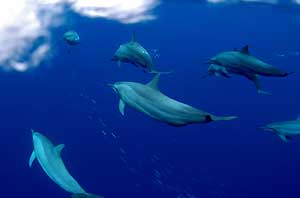 Environmentally conscious, FeBrina ties up to permanent moorings on top of the reef thereby eliminating any damage to the delicate substrate. Ample back deck area provides easy access to your dive gear and plenty of room to kit up, and attentive dive crew are on hand to assist divers with camera gear... the next thing you know you are in the water.
Environmentally conscious, FeBrina ties up to permanent moorings on top of the reef thereby eliminating any damage to the delicate substrate. Ample back deck area provides easy access to your dive gear and plenty of room to kit up, and attentive dive crew are on hand to assist divers with camera gear... the next thing you know you are in the water.
"Every dive will be a new experience."
Note: Environmental and Safety Fee payable in advance with final payment, currently $6 per person/per night (subject to change).
2 single cabins available on any one trip.
Inclusions: Accommodation on board MV FeBrina, all meals, four or five dives per day, filled tanks (air), weights and weight belt, airport transfers on day of departure and disembarkation, final night dinner at Walindi Resort or on board depending on itinerary, daily light laundry.
Departure time is no earlier than 6pm on the first day, and disembarkation is no later than 9am on the final day.
NITROX IS AVAILABLE: Enquire about trip nitrox packages and save.
Notes
This dive cruise can be incorporated into a Symbiosis tailor made holiday to Papua New Guinea that can be adapted and tailored to meet your dates, preferences and passions. Please contact one of our bespoke holiday planners to create the ideal itinerary for you.
Walindi/Walindi
Kimbe Bay, Witu Islands, Fathers Reefs
Walindi/Walindi North Coast itineraries take in Kimbe Bay, Witu Islands and Fathers Reefs. The best times to do this itinerary are April and May through to mid June, and September, October and November.
This itinerary is usually set for 10 nights and eight and a half days diving (although different duration trips can be organized for groups). The diving includes the feminine reefs of Kimbe Bay with gardens of fan corals, sea whips, and every other variety of coral you can think of, plus an astounding reef fish and invertebrate population which is great for both wide angle and macro photographers.
Then normally heading in a clockwise direction, Febrina sails to the Witu Islands to the north west of Kimbe Bay, which is also very diverse diving suitable for both wide angle and macro photographers.
Witu Islands has great black sand beaches and, depending on the water temperatures, you will get different sorts of critters at different times of year. The signature dive in this area is Krakafat (Lama Shoals) which features huge schools of jacks and barracuda. Many divers would concur that it is the best dive of it’s kind that they have ever done. It is a hard one to beat.
From Witu Islands, Febrina then heads in an Easterly direction to the Father’s Reef system. “The Father” is a large extinct volcano underwater and we dive the outer edges of the crater. Alan describes these reefs as “masculine”... as compared to Kimbe Bay’s “feminine” reefs. As these are oceanic reefs at Father’s, the visibility is quite good to excellent 95% of the time. This is where you are most likely to get pelagic activity, from sharks, dog tooth tuna and barracuda through to a group of spinner dolphins. They are there around 70% of the time and you could get to snorkel with them for half an hour.
The signature dive at Fathers is Kilobob’s. Normally you can do two dives here on the morning of the last day in the Father’s reefs area. This is quite a sharky dive with schools of barracuda and jacks. From Kilobob’s, Febrina starts the steam back towards Kimbe Bay, skipping the third dive of the day. Depending on the weather conditions, she may stop to dive a sea mount on the way back into Kimbe Bay (Walindi Reefs) at around 14:00 before headinf to Restorf Island, arriving at around 17:00 for a dusk or night for those that want to.
Normally a Walindi/Walindi trip will start with one to two days on the Walindi reefs in Kimbe Bay, head to Witus for two to three days, overnight steam to Father’s Reefs for three to four days and then back into Walindi Reefs for either one and a half, or half a day, depending on where the diving is optimal.
Schedules are structured to maximize diving time while you are in Papua New Guinea. On all our trips, first dive of the day is at 6:30am with a time limit on this dive of one hour, working up an appetite for a hearty breakfast on return from the dive. If you need to eat before you dive, a continental breakfast is available from 5:30 onwards.
Second dive is at 09:00 which then allows for another dive before lunch at 13:00. This gives you the opportunity, although not compulsory, to do three dives before lunch. Typically divers will do wide angle in the morning and macro in the afternoon.
Lunch is usually around 13:00 followed by a siesta, and the afternoon dive is at around 15:00 to 15:30. Darkness in Papua New Guinea falls at around 18:30 which enables divers to do a night dive before dinner.
Notes
Environmental and safety fees apply
Walindi/Rabaul
Kimbe Bay, Fathers Reefs, Rabaul
This itinerary departs from Walindi Resort and includes diving in Kimbe Bay, before visiting Fathers Reefs on the way around to the Rabaul area, concluding in Rabaul. Fly into Hoskins (HKN) airport and fly out of Tokua (RAB) airport at Rabaul.
Rabaul, Fathers Reefs, Kimbe Bay
This itinerary departs from Rabaul, diving the Rabaul area, then onto the exciting Fathers Reefs system, before finishing off with the Kimbe Bay area, concluding at Walindi Resort. Fly into Tokua (RAB) airport at Rabaul, and fly out of Hoskins (HKN) airport.
These itineraries are scheduled from mid June through to end of August. These are generally 9 night/7.5 dive day trips and take in Walindi reefs, Fathers Reefs, the area around the Gazelle Peninsula and Rabaul.
The Rabaul area is quite exciting. Although not as “fishy” as Father’s Reefs, it has some very beautiful reef and spectacular critters.
There are certain areas in Papua New Guinea where two seas meet and this appears to produce unusual and wonderful “critter” life. Milne Bay (where the Coral Sea meets the Solomon Sea) and Kavieng (where the Bismarck Sea meets the Pacific Ocean) are two of these areas. Rabaul is another such area, where the Solomon Sea meets the Bismarck Sea.
During the mid months of the year, the currents change and the temperatures drop from 86 degrees to 82 degrees in the areas we dive. This little drop in temperature in the Rabaul and surrounding area brings out some rare and unusual critters.
Febrina's signature dives in the Rabaul area are not wide angle by any means, but Sandra’s Jetty and Nonga Beach have astounding critter life. From frogfish, ghost pipefish of all flavours, seahorses and flying gunards, to nudibranchs of every shape, size and description, these two reefs have it all and more. At Horseshoe Reef, we normally have good schools of barracuda along with soft corals and a great dusk dive where we regularly find mandarin fish.
Once we get to Father’s Reefs, those people that like the bigger fish action are in their element. See previous descriptions of the diving at Fathers in the section on Walindi/Walindi itinerary.
Febrina then moves back around into Kimbe Bay and the Walindi Reefs and the trip finishes with the drop dead gorgeous reefs in the Bay.
Rabaul itself has a magnificent war history, not to mention the active volcano shadowing the town. Visitors are always impressed with the unique and special sight of an active volcano puffing out plumes of smoke, and a land tour is a must.
Rabaul/Rabaul
South Coast New Britain itineraries
This itinerary departs from Rabaul, heading around to the Southern Coast of New Britain, including Waterfall Bay, Lindenhaven and Gasmata, returning to Rabaul. Fly into and out of Tokua (RAB) airport at Rabaul.
These itineraries are scheduled during January, February and through to mid March. The South Coast of New Britain Island, due to the high mountain range down the middle of the island, experiences it’s dry season at this time, with the winds remaining off shore.
The South Coast is totally different to the other itineraries. If you are a 100% of the time big fish person, it is probably not the itinerary for you, although there are some fantastic sharky drift dives and a couple of sea mounts which are impressive when dived at the turn of the tide. With the right conditions on these sites, you never know what might turn up … exciting stuff.
Febrina departs from Rabaul in the evening of the departure day and sails overnight to Waterfall Bay. Diving begins the next morning in Waterfall Bay exploring the various reefs in this area.
The second night is an overnight steam to the Lindenhaven area where most of the trip will be spent, hardly moving out of a one square mile area. The reefs in this area are prolific and there are many, many reefs still to discover. Although Lindenhaven has lagoon-like features, the channels and currents continually flushes the water. Within the lagoon, there are two clean rivers that deposit a certain amount of fresh water. One of the rivers comes out of a cave in the side of a mountain which can be reached by jetboat. Good fun!
One other phenonoma of Lindenhaven is that the contours of the Solomon Trench (the third deepest part of the world’s oceans at 32,000 feet) come in very close.
This maybe a reasonwhy there are some extraordinary critters in this area … some of them that can’t be found in any resource books. Many of the dives are in black sand and where Febrina's experienced dive guides act as excellent “spotters”.
In 2007, they saw mimic octopus, frogfish, one guest documented 47 different ghost pipefish covering almost every variety found in the books, jaw fish, cuttlefish, arrow crabs, orangutan crabs, leaf scorpion fish, rock mover wrasse, pipefish, anemone fish, holothurians, banded shrimp, lionfish, scorpion fish, crocodile fish, soft coral crabs, flying gurnards, nudibranchs of every description, bubble shells and cowry shells, garden eels, flatworms, Spanish dancer and much more. Some years Rhinopious are also seen. You never know what you are going to find and this has a lot to do with water temperatures.
This is critters paradise: If you like Lembeh Straits, Ambon and Kunkungen Bay, then you won’t be disappointed with Lindenhaven.
There are some wide angle diving in the Lindenhaven area. If the currents are doing the right thing, the passages on incoming tides are absolutely fantastic. with sightings of devil rays (mobulas), barraduca, silvertips, eagle rays, spotted zebras, large schools of bumphead parrot fish and unbelievable soft corals in every colour.
On the way back to Rabaul, Febrina will stop at a place called Tavalo. A highlight is to talk a walk with the local people through the jungle on a reasonable path to a waterfall that has a small but deep swimming hole at the bottom. The 30 minute walk also passes through the village gardens where they grow sweet potato and all the other local produce. It is very interesting to see how they go about their subsistence living.
After Tavalo, head back to Waterfall Bay for the day and then overnight to Rabaul where Febrina will spend the last half day (weather allowing) diving Sandra’s Jetty. If the weather is being unkind in the Rabaul area, there are other options available in more protected sites.
The MV Febrina
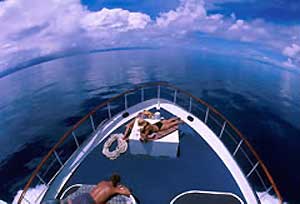
Given a five star rating in all categories in a leading dive guide and highly recommended in the prestigious Harper & Queen, MV FeBrina is a 72 foot long vessel, fully air-conditioned and fitted with all the usual conveniences.
FeBrina is an extremely comfortable boat in all ways, with a friendly and experienced crew providing top class service. Sea worthy and stable, accommodation is in seven roomy twin share cabins with ample storage space. Meals provided by a top class chef are plentiful and fresh, with lots of fruit between dive snacks.
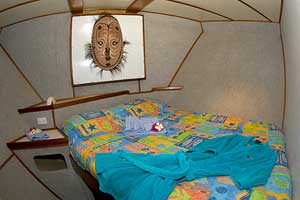
ACCOMMODATION
Single Cabins (1,2)
Aft, 1 twin bed (upper) and 1 twin bed (lower), semi-private facilities, en-suite sink, porthole view, wardrobe, mirror, bathrobes, hairdryers, soaps, fresh towels daily, personal laundry daily
Deluxe Twin Cabins (3,4)
Aft, 4 twin beds (2 upper and 2 lower), semi-private facilities, en-suite sink, porthole view, wardrobe, mirror, bathrobes, hairdryers, soaps, fresh towels daily, personal laundry daily
Deluxe Cabins (5,6)
Forward, 1 large twin bed (lower) and 1 twin bed (upper), private facilities, porthole view, wardrobe, mirror, bathrobes, hairdryers, soaps, fresh towels daily, personal laundry daily
Owner's Stateroom (7)
Forward, double bed, private facilities, porthole view, wardrobe, mirror, bathrobes, hairdryers, soaps, fresh towels daily, personal laundry daily


FeBrina's Specifications
Flag: Papua New Guinea
Port of registry: Rabaul
Commissioned: 1972
Refit: 1997
Built: Fremantle, Western Australia
Type: Steel Mono Hull
Length: 21.84 metres (72 feet)
Beam: 6.05 metres (20 feet)
Draft: 11.829 metres (6 feet)
Number of passengers: 12
Accommodation: 7 cabins
Number of crew: 9
Length of Charters: 6-10 nights
Dives Per Day: Up to 5
Number of Tenders: 1 (18 feet) fiberflass
Net tonnage: 68.30 tons
Total Displacement: 127 tons
Fuel capacity: 9 tons (8,333 litres)
Fresh water capcity: 12 tons (12,000 litres)
Desalination Production: 500 gallons/day (750 litres/day)
Speed max: 11.5 knots
Cruising speed: 8.5 knots
Vessel range: 1,500 nautical miles
Navigation Aids: VHF, SSB, Color radar, Echo Sounder, Auto pilot, Sat Nav, 2 X GPS
Main engines: Two Cummins 250hp 1,800rpm each
Propellers: Two four bladed fixed
Generators: Two x 415/240V 70KVA Perkins
Compressor: Atlas Copco Nitrox Low Pressure Compressor, 2 x Bauer 14 cuft compressors
Compass: Tokyo Keiki GM11
Voltage: 220 volt
Air-conditioning: To all area, individual air conditioning to each cabin
Laundry: Services are available for guests daily
Nitrox: Available per tank or per trip
Diving Instruction: Not available
Gear Rental: Available with notice
CD Player: Yes
Boutique: At Walindi
Equipment Rinse: Yes
Special Dietary Request: Yes
Alcohol Included: Yes, Australian wine is included with dinner. Beer and softdrinks are available for charge. (Please BYO spirits.)
Game Taking Allowed: No
Oxygen On Board: Yes
Nearest Recompression Chamber: Port Moresby, Papua New Guinea
* NOTE. Prices indicated on this website are shown as a guideline only and may be subject to currency fluctuations, banking fees and other changes outside our control. Pricing information is available in
other currencies.
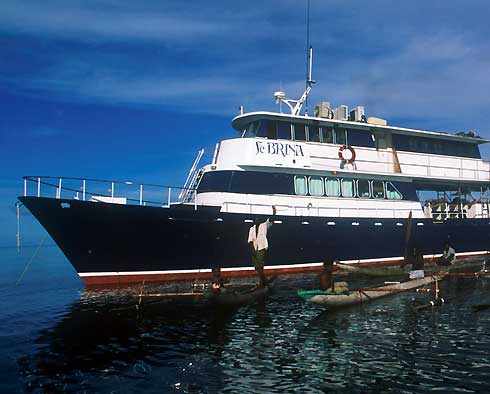

 This superb live-aboard dive vessel is specifically outfitted to allow divers access to the reefs surrounding West New Britain and New Ireland, in Papua New Guinea's two main islands.
This superb live-aboard dive vessel is specifically outfitted to allow divers access to the reefs surrounding West New Britain and New Ireland, in Papua New Guinea's two main islands. Environmentally conscious, FeBrina ties up to permanent moorings on top of the reef thereby eliminating any damage to the delicate substrate. Ample back deck area provides easy access to your dive gear and plenty of room to kit up, and attentive dive crew are on hand to assist divers with camera gear... the next thing you know you are in the water.
Environmentally conscious, FeBrina ties up to permanent moorings on top of the reef thereby eliminating any damage to the delicate substrate. Ample back deck area provides easy access to your dive gear and plenty of room to kit up, and attentive dive crew are on hand to assist divers with camera gear... the next thing you know you are in the water.